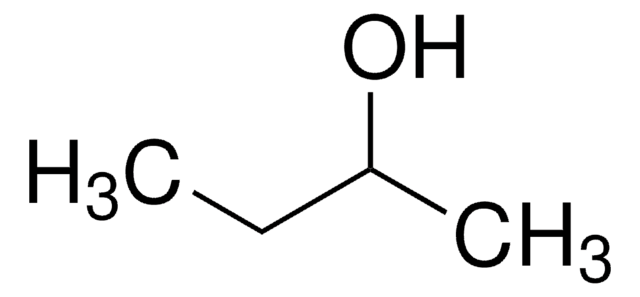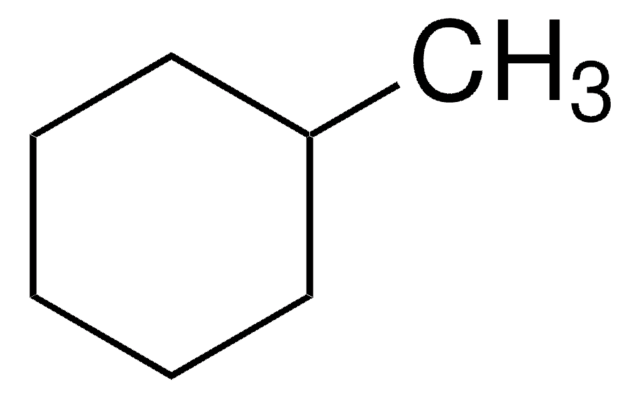Select a Size
All Photos(3)
Select a Size
Change View
About This Item
Empirical Formula (Hill Notation):
C6H6
CAS Number:
Molecular Weight:
78.11
Beilstein/REAXYS Number:
969212
EC Number:
MDL number:
UNSPSC Code:
12352002
PubChem Substance ID:
NACRES:
NA.21
grade:
ACS reagent
assay:
≥99.0%
bp:
80 °C (lit.)
vapor pressure:
166 mmHg ( 37.7 °C)
74.6 mmHg ( 20 °C)
74.6 mmHg ( 20 °C)
Recommended Products
grade
ACS reagent
Quality Level
vapor density
2.77 (vs air)
vapor pressure
166 mmHg ( 37.7 °C)
74.6 mmHg ( 20 °C)
assay
≥99.0%
form
liquid
autoignition temp.
1043 °F
expl. lim.
8 %
dilution
(for analytical testing)
impurities
H2SO4, passes test (darkened)
thiophene, passes test (limit ∼1ppm)
≤0.005% S compounds
≤0.05% water (Karl Fischer)
Looking for similar products? Visit Product Comparison Guide
Related Categories
General description
Benzene is a monocyclic aromatic compound used as a solvent in chemical reactions. It is an essential raw material for fuels, rubber and plastics products, detergents, pesticides, and pharmaceuticals.
Application
Benzene can be used as a solvent in the:
- Heck Reaction of vinyl bromides with styrenes to synthesize functionalized 1,3-dienes.
- Gallium-catalyzed reductive lactonization of γ-keto acids to γ-lactone derivatives.
- Anionic polymerization of styrene and 1,3-butadiene in the presence of phosphazene as a base.
signalword
Danger
Hazard Classifications
Aquatic Chronic 3 - Asp. Tox. 1 - Carc. 1A - Eye Irrit. 2 - Flam. Liq. 2 - Muta. 1B - Skin Irrit. 2 - STOT RE 1
target_organs
Blood
Storage Class
3 - Flammable liquids
wgk_germany
WGK 3
flash_point_f
12.2 °F
flash_point_c
-11 °C
Choose from one of the most recent versions:
Already Own This Product?
Find documentation for the products that you have recently purchased in the Document Library.
David Galbraith et al.
Critical reviews in toxicology, 40 Suppl 2, 1-46 (2010-10-14)
Over the last century, benzene has been a well-studied chemical, with some acute and chronic exposures being directly associated with observed hematologic effects in humans and animals. Chronic heavy exposures to benzene have also been associated with acute myelogenous leukemia
Deborah C Glass et al.
Occupational and environmental medicine, 71(4), 266-274 (2014-02-18)
Benzene exposure has been associated with increased risk of leukaemia and myelodysplastic syndrome. Existing studies are sparse for other lymphohaematopoietic cancer subtypes, such as myeloproliferative disease (MPD) and the related chronic myeloid leukaemia (CML). We pooled data from three petroleum
Audrey Smargiassi et al.
Environmental research, 132, 38-45 (2014-04-20)
The acute cardiorespiratory effects of air quality among children living in areas with considerable heavy industry have not been well investigated. We conducted a panel study of children with asthma living in proximity to an industrial complex housing two refineries
Jelle Vlaanderen et al.
Environmental health perspectives, 119(2), 159-167 (2010-10-01)
The use of occupational cohort studies to assess the association of benzene and lymphoma is complicated by problems with exposure misclassification, outcome classification, and low statistical power. We performed meta-analyses of occupational cohort studies for five different lymphoma categories: Hodgkin
Cliona M McHale et al.
Carcinogenesis, 33(2), 240-252 (2011-12-15)
Benzene causes acute myeloid leukemia and probably other hematological malignancies. As benzene also causes hematotoxicity even in workers exposed to levels below the US permissible occupational exposure limit of 1 part per million, further assessment of the health risks associated
Our team of scientists has experience in all areas of research including Life Science, Material Science, Chemical Synthesis, Chromatography, Analytical and many others.
Contact Technical Service





